This post is a handwritten visual book notes or sketchnotes / summary and review of Jim Kwik’s book Limitless. Gentle warning: This post is over 3,700 words long!
Table of Contents
Introduction
I am mostly a visual learner and I’ve been sharing digital visual summaries of books.
But I am not much of an artist.
However for the Limitless book, I decided to start a journal and draw out the big ideas since there are lots of benefits of note-taking by hand.
I kind of thought my handwriting and drawings were bad at worst and kiddish at best.
Nevertheless I started sharing my book notes to the Kwik Brain Podcast (Limitless Community) Facebook group (an awesome group for those interested in learning how to learn) in the hope that it would be helpful to someone.
I was totally blown away because the response was unexpectedly good and people were so encouraging!
You can see the first few notes were text heavy but as my confidence grew it became more image heavy 🙂
Even Jim Kwik liked and commented on many of my book notes. What?
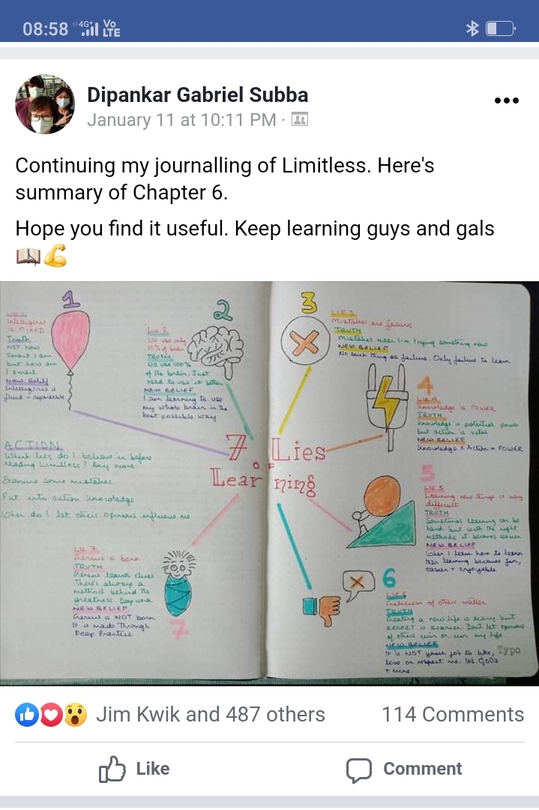
But there was a problem.
Many had trouble finding all the notes in order.
So I decided to put all my handwritten notes of Limitless chapter by chapter in this blog post.
Note: I’ll redact some parts that are personal for me.
Limitless Model, Chapter 2: Why This Matters Now & Chapter 3: Your Limitless Brain 🧠
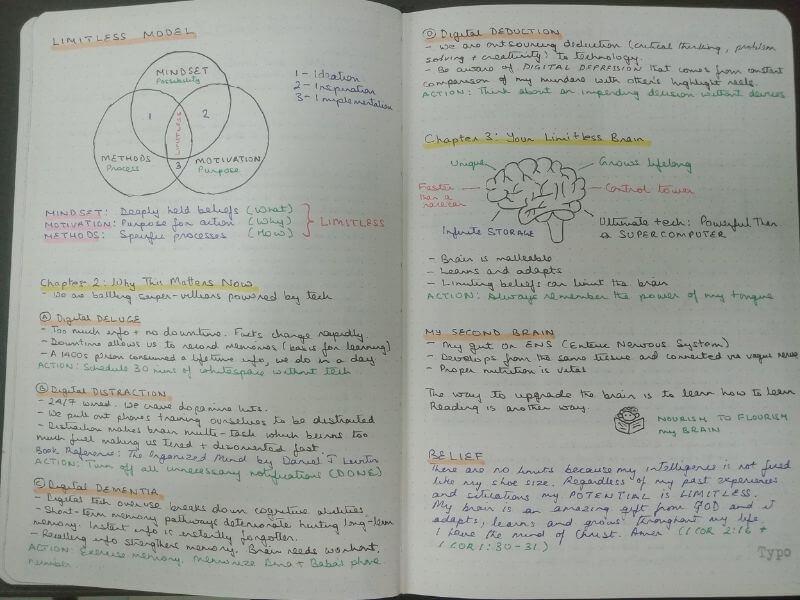
The Limitless Model consists of three major areas:
- Mindset (deeply held beliefs – WHAT)
- Motivation (Purpose for action – WHY)
- Methods (specific processes – HOW)
At the intersection of mindset, motivation and methods is the limitless you!
Chapter 2 deals with the villains we are battling in our quest for limitless learning in this day and age. These villains are:
- Digital DELUGE
- Digital DISTRACTION
- Digital DEMENTIA
- Digital DEDUCTION
- Digital DEPRESSION
Chapter 3 is all about our awesome and limitless brains plus how we have a second brain which is our gut. The gut or ENS (Enteric Nervous System) develops from the same tissue as the brain and is connected via the vagus nerve. Therefore, proper nutrition is vital.
Chapter 4: FASTER Method 🏃💨
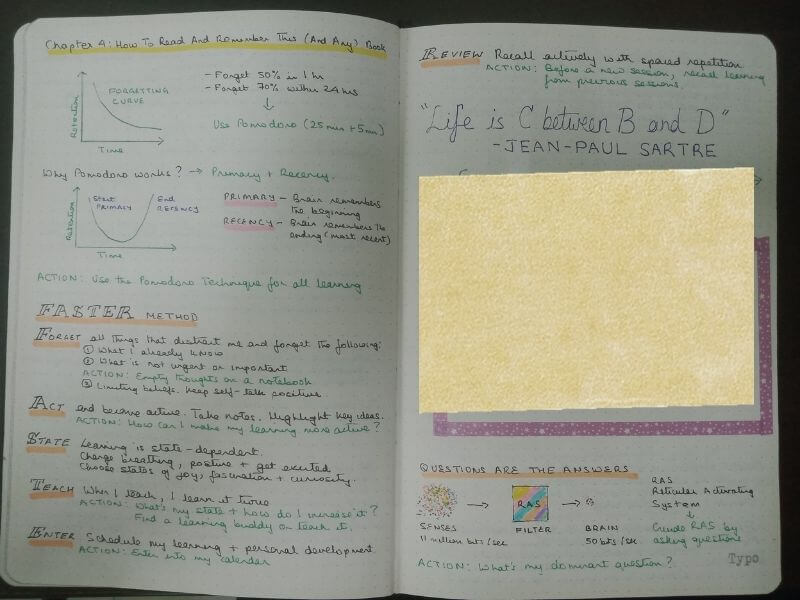
Chapter 4 introduces a technique called the FASTER method to read and remember efficiently.
- F – FORGET what distracts you, set aside what you already know and keep limiting beliefs at bay.
- A – ACT and make learning more active. Shed the passive mindset.
- S – STATE which means your state of mind. Choose states of joy, fascination and curiosity. Change posture and breathing.
- T – TEACH it to someone because when you teach you learn it twice. This was one of the reasons I started sharing my book notes.
- E – ENTER it into your calendar. Schedule a time for learning and personal development.
- R – REVIEW your learning with spaced repetition using active recall.
Questions are the key to learning so learn to ask better questions like:
- How can I use this learning?
- Why must I use this learning?
- When will I use this learning?
Part 2 – Limitless Mindset & Chapter 5: The Spell of Belief Systems 🙏
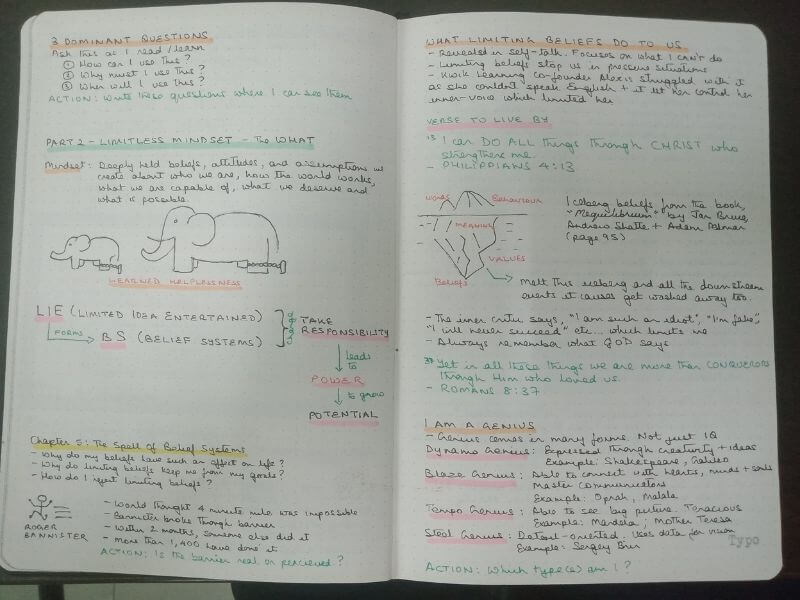
Mindset comes from deeply-held beliefs about our identity, the world and what is possible. It is also the reason for learned helplessness.
LIE (Limited Idea Entertained) ———> BS (Belief Systems)
To change, take RESPONSIBILITY which leads to POWER that grows into POTENTIAL.
Chapter 5 is all about the spell of belief systems. Examine closely how certain beliefs have hindered you and what can you do to overcome the obstacles.
Before Roger Bannister, the world thought a 4-minute mile was impossible but after he broke that milestone more than 4,000 people have achieved that “impossible” feat!
It is vital to shut the inner critic which says, “I am such an idiot” or “I’ll never succeed” especially during crunch times.
- Name your inner critic
- Get to the facts NOT the emotions
- Create a new empowering belief
Chapter 6: The 7 Lies of Learning 🤥
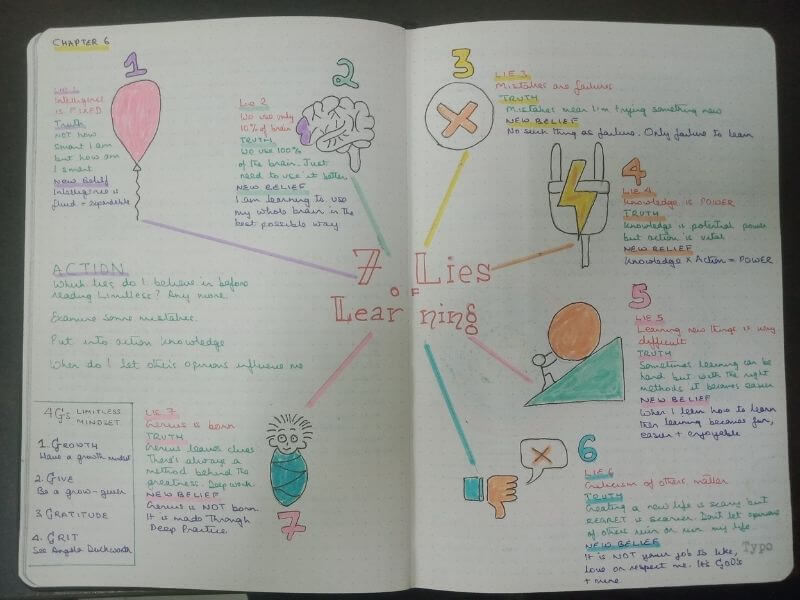
There are seven vicious lies when it comes to learning:
- Intelligence is FIXED: Nothing could be further from the truth. It is NOT how smart you are rather how are you smart. In what ways are you smart.
- We use only 10% of our brains: We use 100% of our brains for different things. The key is to learn how to use your brain better.
- Mistakes are FAILURES: Mistakes are merely feedback and it means you are trying something new.
- Knowledge if POWER: Wrong because knowledge without application is hollow.
- Learning new things is very DIFFICULT: Yes, learning can be hard at times but with the right techniques it becomes easier.
- CRITICISM of others MATTER: Yes, change can be scary or difficult but don’t let the opinions of others run or ruin your life.
- Genius is BORN: Genius always leaves clues and there is always a method behind the greatness.
ACTION: Create a NEW BELIEF for each of the 7 lies.
Part 3 – Limitless Motivation & Chapter 7: Purpose 🙌
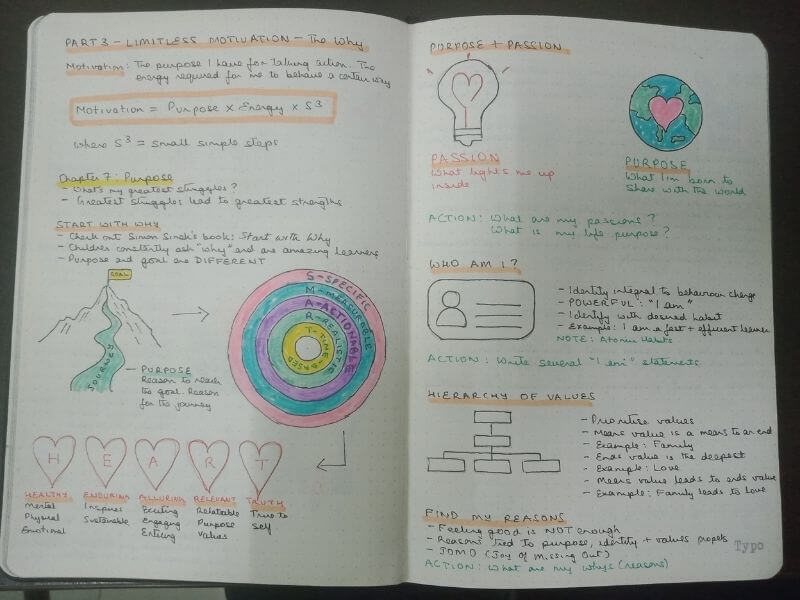
Jim Kwik’s formula for motivation is quite ingenious:
Motivation = Purpose X Energy X S3
where S3 = small simple steps
Chapter 7 is all about purpose and how it is different from passion. Passion is the thing that lights you up inside (for me, it is learning) and purpose is what you were born to share with the world.
Two things are vital for behaviour change: identity and values.
The two words: “I am” is powerful. To change yourself, you must change your identity.
Prioritise values and differentiate between means value and ends value. Create a hierarchy of values to guide you.
Chapter 8: Energy ⚡
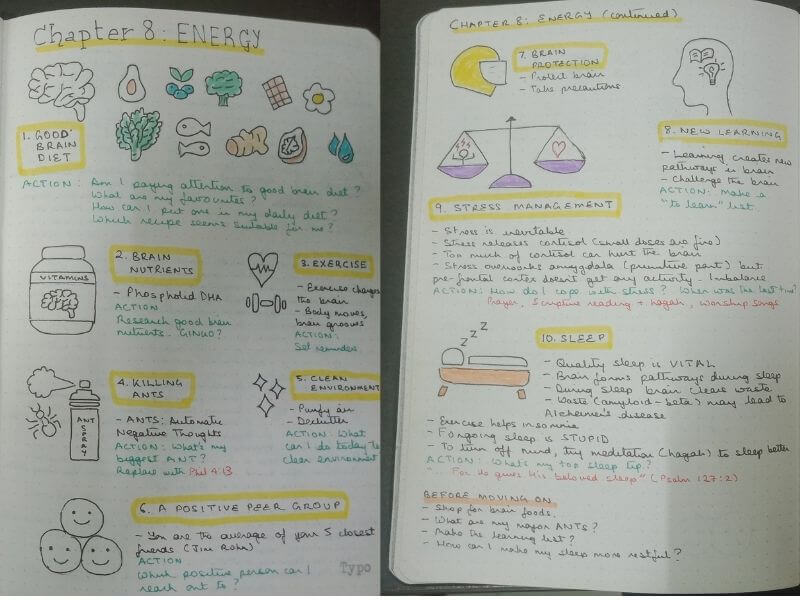
Chapter 8 is all about energy and how it is important to create and manage it through proper nutrition and mindset among other things. The 10 things Jim touches on are:
- Good brain diet: Include these food items in your diet: avocado 🥑, blueberries 🫐, broccoli 🥦, dark chocolate 🍫, eggs 🥚, leafy green vegetables 🥬, fish 🐟, turmeric, walnuts and water 💧.
- Brain nutrients like Phospholipid DHA.
- Exercise changes the brain.
- Kill your ANTS that is your “Automatic Negative Thoughts” and replace it with something empowering.
- Clean your environment because the brain works best when the environment is clean and clutter-free.
- Hang out with a positive peer group.
- Protect your brain: Always wear a helmet in activities which are risky or avoid risky activities.
- New learning creates new pathways in the brain so it is good to challenge the brain with new learnings.
- Stress management is vital because stress releases cortisol which can be harmful to the brain in the long run. Think of ways to destress.
- Sleep is important as the brain declutters itself during sleep as well as forms new pathways.
Chapter 9: Small Simple Steps 👣
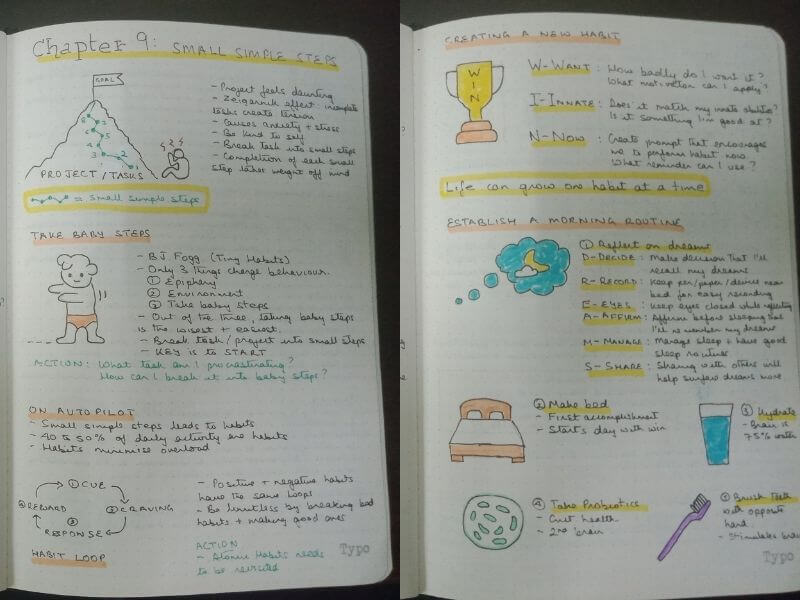
Break a project down into small manageable steps.
Small simple steps lead to habits which consist of 40 to 50% of our daily activities. Positive and negative habits have the same loops:
1. Cue —–> 2. Craving —–> 3. Response —–> 4. Reward
To create a new habit, remember the acronym WIN.
- W – WANT: Ask the following questions: “How badly do I want this habit?” and “What can motivate me?”
- I – INNATE: Ask the following questions: “Does it match my innate abilities?” or “Is this something that I am good at?”
- N – NOW: Create prompts that encourage you to perform the habit now. What reminders can you use?
Also tap into the power of morning routines. A good morning routine can set you up in the path of success.
Chapter 10: Flow 🌊
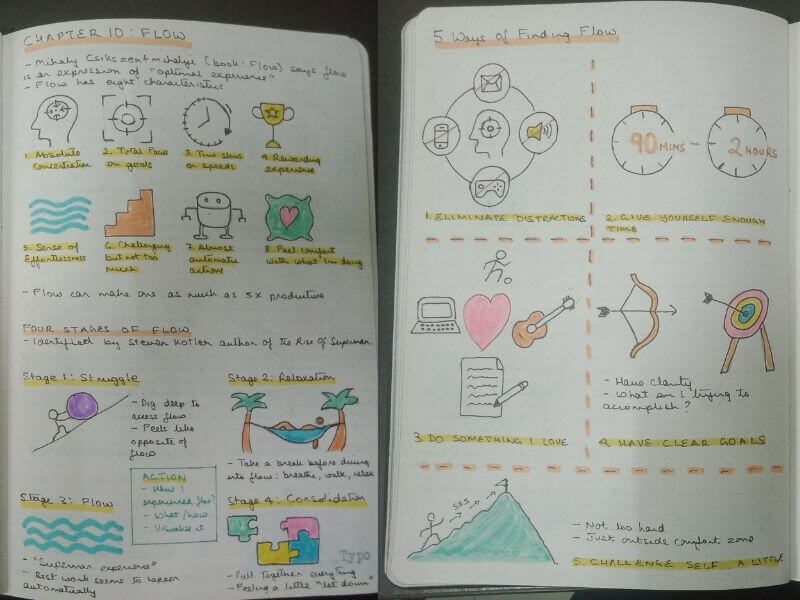
Flow is an expression of “optimal experience” and has eight characteristics:
- Absolute concentration
- Total focus on goals
- Time stands still or speeds up
- Rewarding experience
- Sense of effortlessness
- Challenging to the right degree
- Almost automatic actions
- Feeling of comfort with the task
There are 4 stages of flow:
- Struggle: Which feels like the opposite of flow. You need to dig deep to access flow.
- Relaxation: Take a break before diving into flow.
- Flow: Superman experience. Best works happens almost automatically.
- Consolidation: Pull together everything. A feeling of being a little “let down”
There are 5 ways to find flow:
- Eliminate distractions
- Give yourself enough time (90 minutes to 2 hours)
- Do something you love
- Have clear goals
- Challenge yourself just a little. Not too hard. Not too easy.
Conquering The Enemies Of Flow ⚔️
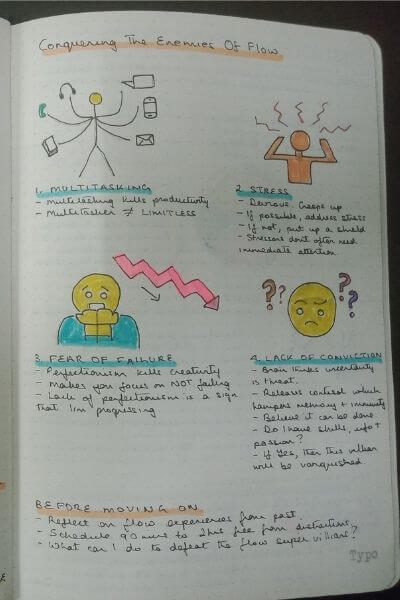
To become limitless, you need to get into the state of flow and so its important to know the enemies of flow and vanquish them.
- Multitasking: This kills productivity and so it is best to do one thing at a time without switching back and forth.
- Stress: This enemy is devious and creeps up when you are getting into flow state. If possible, address the stressor beforehand else put up a shield to protect yourself. Oftentimes, stressors don’t need immediate attention.
- Fear of Failure: Perfectionism kills productivity and flow making you focus on NOT failing instead of progress. Change your belief to “lack of perfectionism is a sign that I’m growing.”
- Lack of Conviction: Brain thinks uncertainty is a threat so it releases cortisol which hampers memory and immunity. Believe strongly it can be done. Assess whether you have the skills, information and passion and if the answer is yes, forge ahead!
Part 4 – Limitless Methods & Chapter 11: Focus 🔍
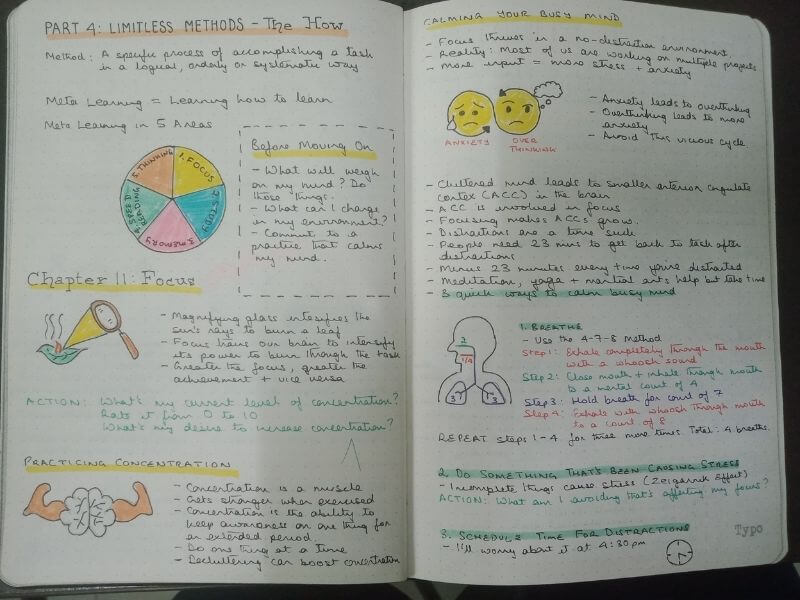
Part 4 delves into the methods or the how and chapter 11 is all about focus.
Concentration can be practiced and it is a learnable skill.But first, it is vital to calm your mind.
Remember anxiety leads to overthinking which leads to more anxiety. A vicious loop.
There are 3 quick ways to calm a busy mind:
- Breathe: Use the 4-7-8 method.
- Exhale completely through the mouth with a whoosh sound.
- Close mouth and inhale through nose for a count of 4.
- Hold the breath for a count of 7.
- Exhale with a whoosh through the mouth for a count of 8.
- Repeat steps 1-4 for a total of four breaths.
- Tackle something that’s been causing stress. Action cures stress and incomplete things cause stress.
- Schedule time for distractions. For example, “I’ll worry about that at 4:30pm.”
Chapter 12: Study 📜
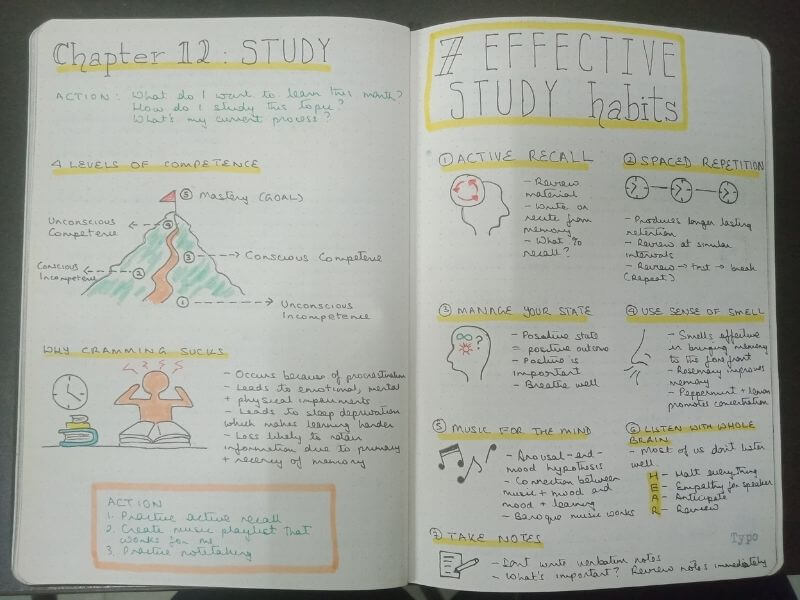
Chapter 12 on study dives straight into levels of competence followed by a discussion on why cramming is ineffective. Instead of cramming practice active recall and work on notetaking.
The 7 effective study habits are:
- Active Recall: Review material. Write or recite from memory and note what percentage you can recall.
- Spaced Repetition: Review material at similar intervals which produces longer lasting retention.
- Manage Your State: Breathe well and main a positive frame of mind.
- Use Sense Of Smell: Your sense of smell is really effective in bringing memories to the forefront. Rosemary improves memory and peppermint and lemon promotes concentration.
- Music: There is a connection between music and mood as well as mood and learning. Baroque music is great for learning.
- Listen With Whole Brain: Learn to listen. Use HEAR to help: H is to halt everything, E is to have empathy for the speaker, A is to anticipate and R is to review.
- Take Notes: Engage in taking notes actively but not in verbatim. Review notes immediately.
Chapter 13: Memory 💭
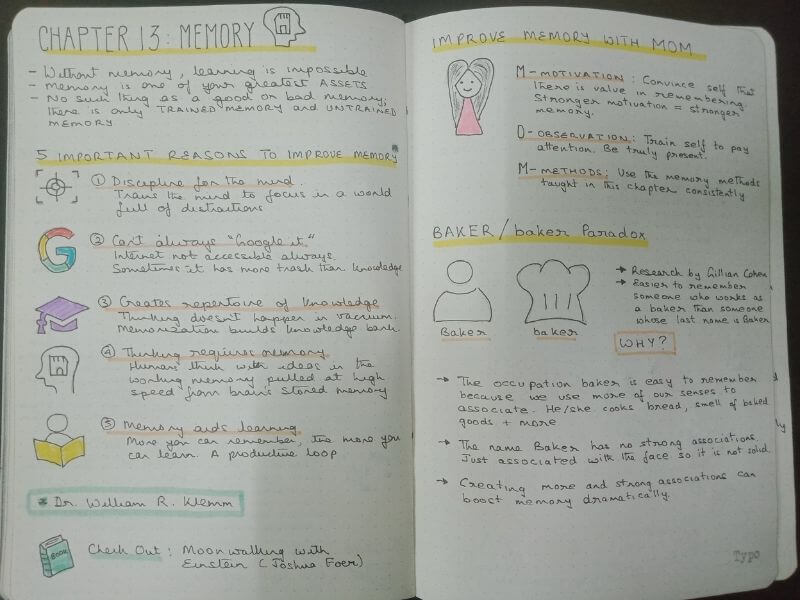
Learning would be impossible without memory. There are 5 important reasons to improve your memory:
- Discipline: It trains your mind.
- Can’t Always Google: You can’t always have access to the Internet. At times, there is more noise than signal online.
- Repertoire Of Knowledge: Memory builds a knowledge bank which makes learning easier.
- Thinking Requires Memory: Humans think with ideas in the working memory pulled at high speed from the brain’s stored memory.
- Aids Learning: The more you can remember, the more you can learn. It is a productive loop.
Improve your memory with MOM:
- M – Motivation: Convince yourself that there’s value in remembering because the stronger the motivation, stronger the memory.
- O – Observation: Train yourself to be truly present and to pay close attention.
- M – Methods: Use the memory methods you learn in this book consistently.
Story Method For Better Memory 📽️
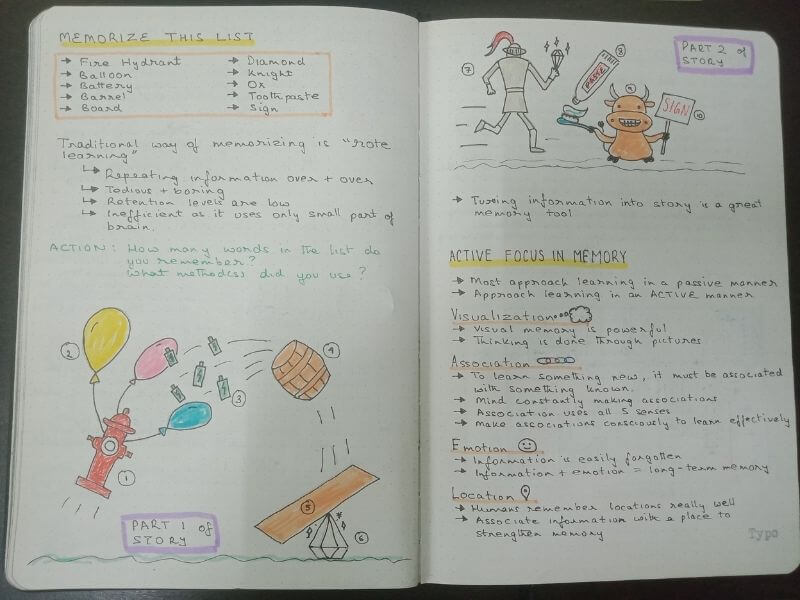
Usually, we are taught how to memorize by rote. Information is learned by repeating the information over and over which is ineffective, boring, tedious and retention is low.
Instead visualize and tell a story about the information you have to learn and memorize.
See the picture above on how I drew out a story to remember the list: fire hydrant, balloons, batteries, barrel, board, diamond, knight, ox, toothpaste and sign.
Make your story vivid and absurd so it will stick to your memory better.
Bonus Tools For A Better Memory 🛠️
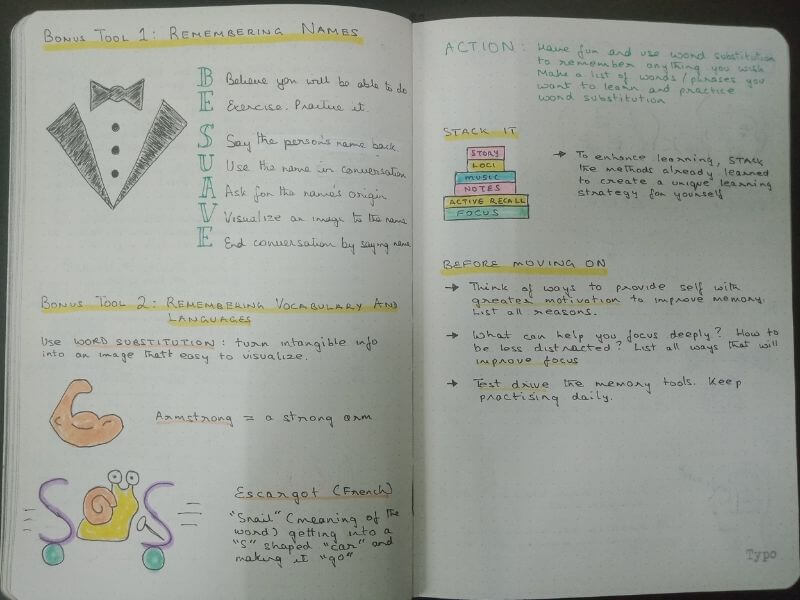
Bonus Tool 1: Remembering Names
Remember the acronym 🤵 BE SUAVE:
- B – Believe you will be able to do it.
- E – Exercise. Practice it regularly.
- S – Say the person’s name back. Don’t overdo it.
- U – Use the name in conversation naturally.
- A – Ask for the name’s origin.
- V – Visualize an image to the name.
- E – End the conversation by saying the person’s name.
Bonus Tool 2: Remembering Vocabulary and Languages
Use word substitution and turn intangible information into an image that’s easy to visualize.
💪 Armstrong = a strong arm
🐌🚗 Escargot (French) is snail (meaning of the word). Imagine a snail getting into an “S” shaped “car” and making it “go” to remember the meaning.
Chapter 14: Speed Reading 📖💨
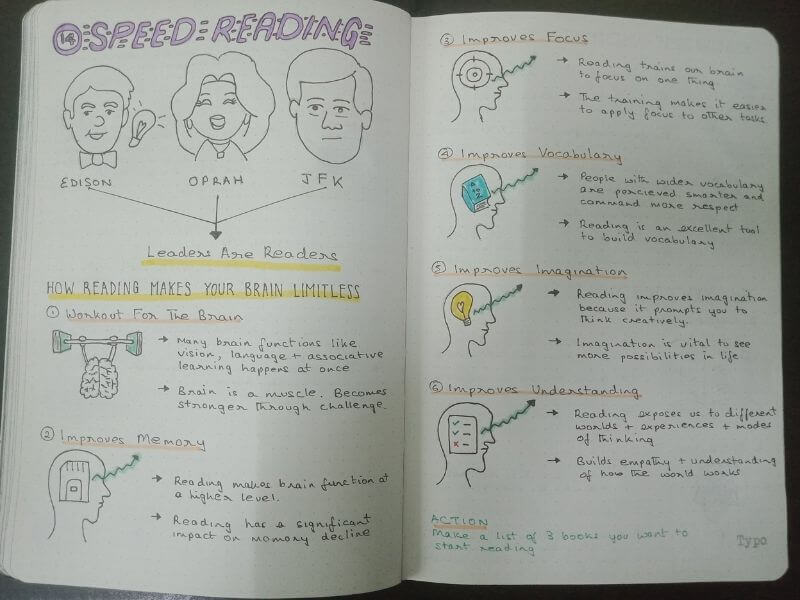
Leaders are readers! To give a few examples, leaders like Buffett, Edison, JFK (a speed reader) and Oprah are/were avid readers.
Here’s how reading makes your brain limitless:
- It’s a workout for the brain as it uses many functions like vision, language and association. The brain is like a muscle which becomes stronger through challenge.
- Reading improves memory as it makes the brain function on a higher level. Reading has a significant impact on memory decline.
- Reading improves focus as it trains your brain to focus on one thing. This training makes it easier to apply focus on other tasks.
- Reading improves vocabulary and people who possess a large vocabulary are perceived as smarter and command more respect.
- Reading improves imagination as it prompts you to think creatively. Imagination is key to see more possibilities in life.
- Reading improves understanding as it exposes you to different worlds, experiences and modes of thinking. It also helps build empathy and understanding of how the world works.
Challenges To Reading 🚧📖
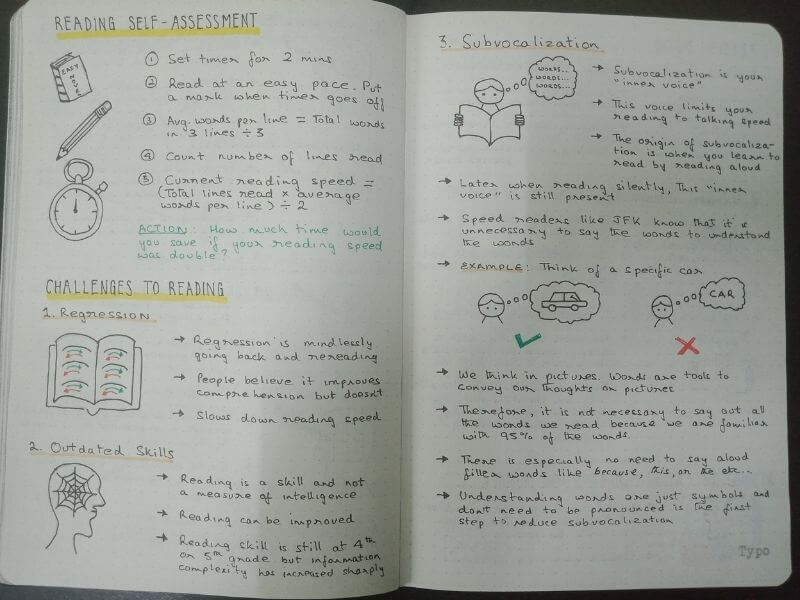
There are 3 major challenges to reading:
- Regression: This is mindlessly going back and rereading lines believing that it will improve comprehension. However, it slows down your reading significantly.
- Outdated Skills: Reading is a measure of skill NOT intelligence. Reading can be improved but your current reading skill is still at a 4-5th grade level but the complexity of the material has greatly increased.
- Subvocalization: This is your “inner voice” which limits your reading speed. When you were young you were taught to read aloud but this habit still persists when reading silently as the “inner voice” is still present. We are already familiar with over 90% of the words we read so there is no need to repeat it.
Reading Myths 📖🐉 & Faster Reading Tips
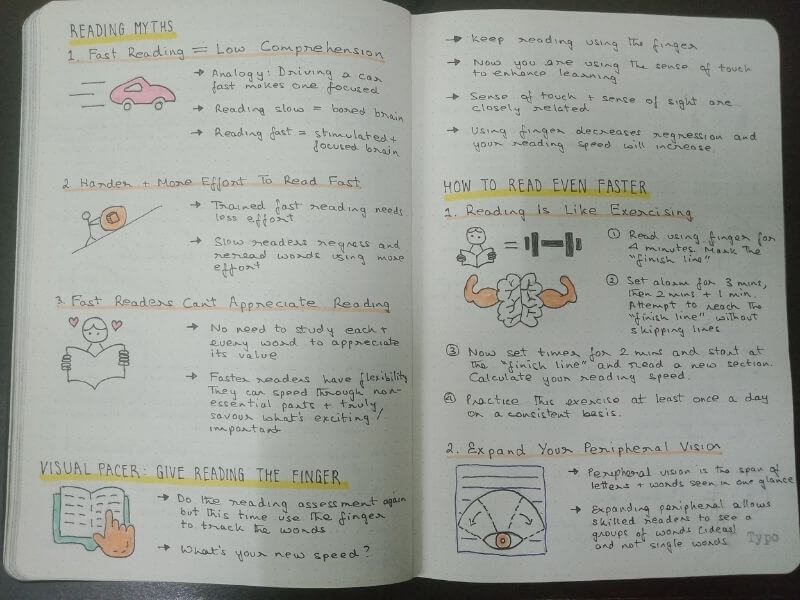
The book addresses three reading myths:
- Fast Reading = Low Comprehension: This is NOT true because when you read slow, you get bored and your mind wanders. Fast reading makes your brain more focused. The analogy is driving a fast car makes one more focused.
- Harder And More Effort To Read Fast: Slow readers regress and reread words using more effort. Fast readers use less effort.
- Fast Readers Can’t Appreciate Reading: Faster readers have more flexibility as they can read faster or slower depending on their preference.
Here are some ways to read faster:
- Give Your Reading The Finger: Use your finger as a visual pacer while reading and record your speed. Your finger reduces regression and speeds up reading.
- Reading Is Like Exercising: The more you read, the faster you’ll get. Set timer and try to progressively read faster.
- Expand Your Peripheral Vision: This is the span of letters and words seen in one glance. It allows you to read a group of words (an idea) and NOT single words.
- Counting: Count aloud: 1, 2, 3, 4… as you read. This will take practice but it will make subvocalization hard increasing speed and comprehension.
- Hold Book Upright: This reduces eye strain and slouching which disrupts oxygen flow in the body causing fatigue easily.
- Use Timer: Read for 20-25 minutes at a times and give your eyes a rest after each session.
- Make Reading A Habit: Read often and make it a daily habit that lasts a lifetime.
Chapter 15: Thinking 🤔
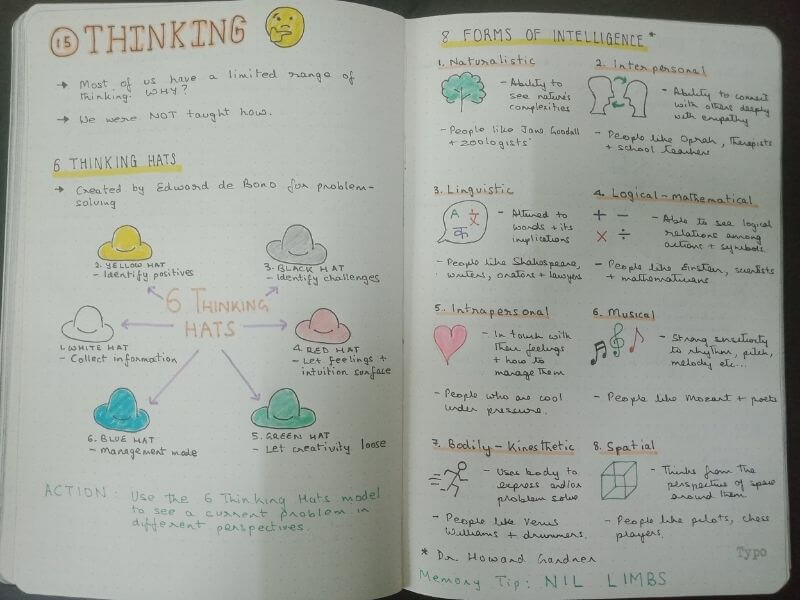
Most of us have a limited range of thinking because we are are simply not taught how to think.
6 Thinking Hats was created by Edward de Bono for problem solving where you wear different metaphorical hats to examine an issue from different angles.
- White Hat: This is the information collecting stage.
- Yellow Hat: This is the stage where you identify all the positives of the issue at hand.
- Black Hat: This is the stage where you identify all the challenges.
- Red Hat: Here you can let your feelings and intuition surface.
- Green Hat: In this stage, you let your creativity loose without any limitations.
- Blue Hat: This is the management mode of looking at the issue or problem you are solving.
8 Forms Of Intelligence was identified by Dr Howard Gardner. What type of intelligence do you identify with most?
- Naturalistic: This is the ability to see nature’s complexities and people who possess this type of intelligence would be Jane Goodall and zoologists.
- Interpersonal: This is the ability to connect with others deeply with empathy. People like Oprah Winfrey, therapists and school teachers possess this type of intelligence.
- Linguistic: People who possess this type of intelligence are attuned to words and its implications. People like Shakespeare, writers, orators and lawyers possess this type of intelligence.
- Logical-Mathematical: Able to see logical relations among actions and symbols. People like Einstein, scientists and mathematicians possess this type of intelligence.
- Intrapersonal: People who are in touch with their emotions and know how to manage them. People who possess this type of intelligence are cool under pressure.
- Musical: This group have strong sensitivity to rhythm, pitch, melody etc. People like Mozart and poets possess this type of intelligence.
- Bodily-Kinesthetic: People who possess this type of intelligence use their bodies to express and/or problem solve. Venus Williams and drummers possess this type of intelligence.
- Spatial: This group of people think from the perspective of space around them. People like pilots and chess players possess this type of intelligence.
Learning Styles, Mental Models & Exponential Thinking🤯

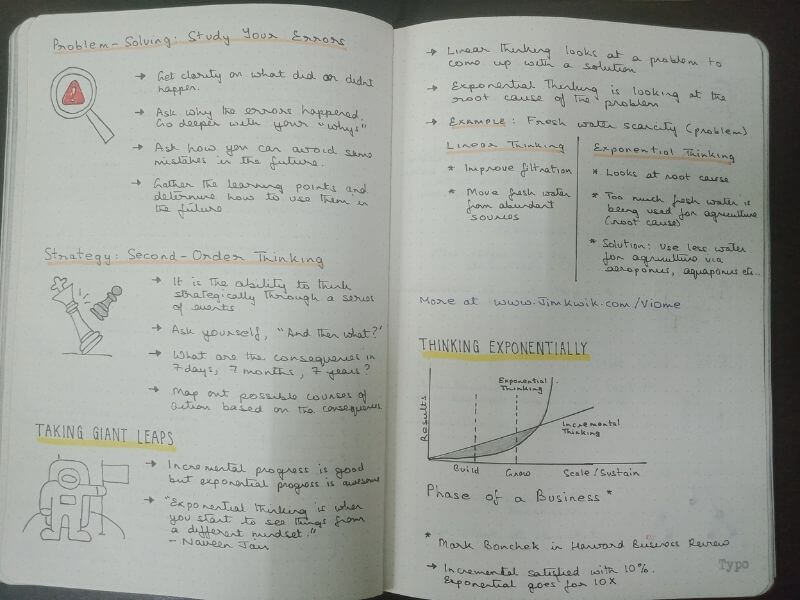
What’s your learning style? The way we learn best differs from person-to-person. VAK is useful to uncover your learning style:
👁️ Visual: Learns best visually through illustrations, videos and visuals.
👂 Auditory: Learns best via listening through audiobooks, lectures, discussions and podcasts.
✋ Kinesthetic: Learns best via physical interaction. These are hands-on learners.
Mental Models are shortcuts to understand the world around us. Mental models train your mind to think and saves time as well as energy. Here are some mental models mentioned in the book:
- Decision-Making: The 40/70 Rule
This mental model is from Colin Powell which states that never make a decision with less than 40% of information available (guessing zone) or with over 70% of information available (stalling zone). The optimal amount of information to possess for decision-making is between 40%-70%. - Productivity: NOT-to-do List
Decide at the start what you’ll NOT do and these items can be the following:- Important tasks that can’t be done yet as external input is required.
- Busy work that add no value which can be delegated or ignored completely.
- Routine tasks that don’t need to be on the to-do list.
- Urgent tasks that can be done by others.
- Problem-Solving: Study Your Errors
- Get clarity on what did or did not happen.
- Probe further and go deeper with your “whys” to uncover the real reason for the error.
- Ask how you can avoid the same mistakes in the future.
- Gather learning points and determine how to use them in the future.
- Strategy: Second-Order Thinking
- This is the ability to think strategically through a series of events.
- Ask yourself, “then what?”
- What are the consequences in 7 days, 7 months, 7 years? Think short-term and long-term.
- Map out possible course of action based on the consequences.
Exponential Thinking is when you start seeing things from a different mindset.
- Linear thinking looks at a problem with a view to come up with a solution.
- Exponential thinking looks at the root cause of the problem.
- Example: Fresh water scarcity (problem)
- Linear thinking solution: Improve filtration. Move fresh water from abundant sources.
- Exponential thinking solution: Look at the root cause which could be that too much fresh water is being used for agriculture. Therefore, the best solution would be for agriculture to use less water via aeroponics, aquaponics etc..
The exponential thinking model is via Mark Bonchek in the Harvard Business Review mainly for businesses but can be applied to many facets of life.
Four Steps To Exponential Thinking 📈💭
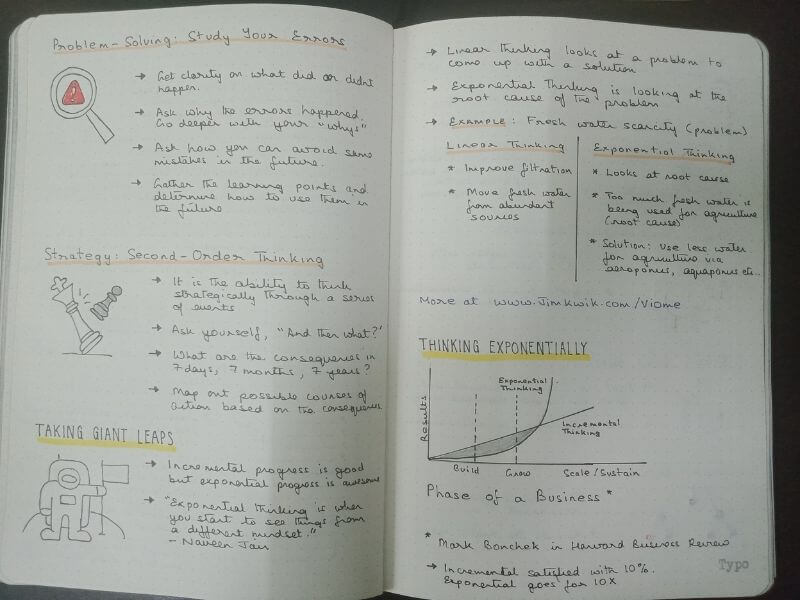
Jim Kwik discusses a four-step method for exponential thinking:
- Get to the underlying problem: Usually there is a “surface” problem and deep down there is an “underlying” problem. The key to exponential thinking is to get to the underlying problem.
- Posit a new approach: Fill your thoughts with “what if” statements which gives rise to unconventional scenarios and solutions.
- Read about it: Reading frees your mind and gives you a well-rounded view of things. Read extensively on alternatives.
- Extrapolate: Play out different scenarios and then decide on the move that’s right for you.
How will you use these lessons to create a limitless life?
But wait there’s more…
10-Day KWIK Start Plan 📅
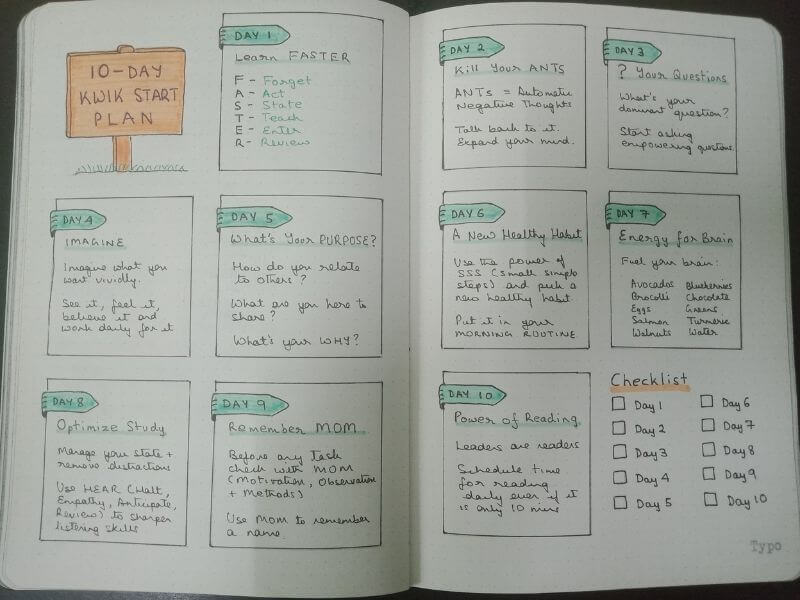
Get All The Notes 📥📖
Wow! You have made it all the way to the end!
And I trust these notes for Limitless have been useful to you.
If you want to take your learning further, get the high definition PDF scanned copy of the updated visual notes below.
Get the Limitless Visual Book Notes on GumroadNever stop learning!
Play the video below to see a sample of the visual book notes for Limitless.
